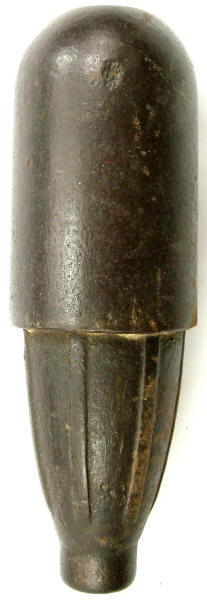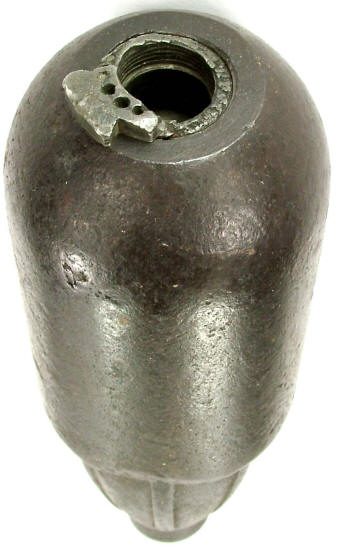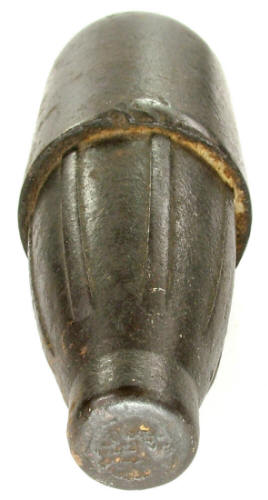A2790...Rifled artillery projectile,
Schenkl design, Federal manufacture, bursting shell, "case shot", lead balls packed in asphalt matrix,
rounded nose, paper sleeve sabot, Schenkl combination fuze early pattern,
Ordnance rifle, 3 in.
    Projectile was manufactured in the Federal arsenals, following the design of
John P. Schenkl. The sabot system consisted of a "forcing cone" paper
sleeve, which was intended to expand into the rifling, then flutter away on
release. Problems with the paper absorbing moisture or swelling and
blocking passage of the flame on firing rendered it impractical with time fuzes
and so it saw limited application. This pattern with rounded shoulder was
designed to hold "case shot" balls, designed to disperse above the heads of
troops in the open field. Lead balls of small size, about .54in. diameter,
are packed in black or asphalt matrix, with long powder train which often will
be off center. Fuze employed was the Schenkl combination fuze,
which was a
complicated contraption designed to ignite either by time or on impact.
This "early" pattern fuze has the percussion mechanism on the top of the
fuze,
Jones pg. 104. Projectile measures: diameter 2.94in., length 9in. (excluding the
fuze), weight 9lbs. Combination fuze is missing the top, case shot balls are inside. Projectile is disarmed, open fuze hole exposes interior, shell may have been recovered in the 19th century or early 20th century,
portions of combination fuze were apparently removed to disarm it. Civil War artifacts
recovered from the Walker/Lupton property just north of Clearbrook, Virginia.
There were two houses on the property, one was called Fairfield and the other
Willow Spring. Virginia Lupton Riley was born at Willow Spring. It is likely
that the Civil War items were found on this property, having passed from her
aunt, Carrie Lupton Bond, who lived at Fairfield until sometime in the 1960's Projectile was manufactured in the Federal arsenals, following the design of
John P. Schenkl. The sabot system consisted of a "forcing cone" paper
sleeve, which was intended to expand into the rifling, then flutter away on
release. Problems with the paper absorbing moisture or swelling and
blocking passage of the flame on firing rendered it impractical with time fuzes
and so it saw limited application. This pattern with rounded shoulder was
designed to hold "case shot" balls, designed to disperse above the heads of
troops in the open field. Lead balls of small size, about .54in. diameter,
are packed in black or asphalt matrix, with long powder train which often will
be off center. Fuze employed was the Schenkl combination fuze,
which was a
complicated contraption designed to ignite either by time or on impact.
This "early" pattern fuze has the percussion mechanism on the top of the
fuze,
Jones pg. 104. Projectile measures: diameter 2.94in., length 9in. (excluding the
fuze), weight 9lbs. Combination fuze is missing the top, case shot balls are inside. Projectile is disarmed, open fuze hole exposes interior, shell may have been recovered in the 19th century or early 20th century,
portions of combination fuze were apparently removed to disarm it. Civil War artifacts
recovered from the Walker/Lupton property just north of Clearbrook, Virginia.
There were two houses on the property, one was called Fairfield and the other
Willow Spring. Virginia Lupton Riley was born at Willow Spring. It is likely
that the Civil War items were found on this property, having passed from her
aunt, Carrie Lupton Bond, who lived at Fairfield until sometime in the 1960's
Ref: Dickey & George,
Field Artillery (1993 Edition), pg. 299.
OCHCWM owned donated by Jim Riley. |